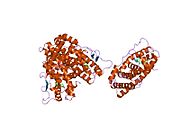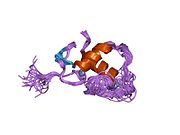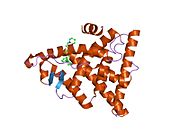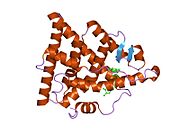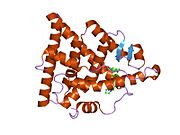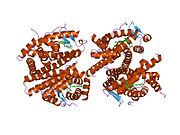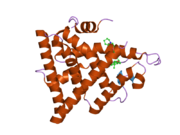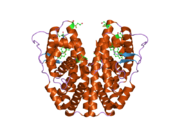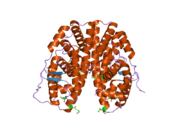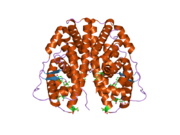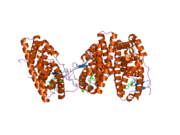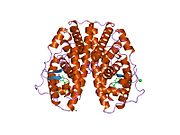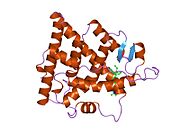Estrogen receptor alpha
| View/Edit Human | View/Edit Mouse |
Estrogen receptor alpha (ERα), also known as NR3A1 (nuclear receptor subfamily 3, group A, member 1), is one of two main types of estrogen receptor, a nuclear receptor (mainly found as a chromatin-binding protein[5]) that is activated by the sex hormone estrogen. In humans, ERα is encoded by the gene ESR1 (EStrogen Receptor 1).[6][7][8]
Structure
The estrogen receptor (ER) is a
Ligands
Agonists
Non-selective
- )
- conjugated equine estrogens)
- )
Selective
Agonists of ERα selective over
- Propylpyrazoletriol (PPT)
- 16α-LE2 (Cpd1471)
- 16α-IE2
- ERA-63 (ORG-37663)
- full agonist
- (R,R)-Tetrahydrochrysene ((R,R)-THC) – actually not selective over ERβ, but rather an antagonist instead of an agonist of ERβ
Mixed
- Phytoestrogens (e.g., coumestrol, daidzein, genistein, miroestrol)
- Selective estrogen receptor modulators (e.g., tamoxifen, clomifene, raloxifene)
Antagonists
Non-selective
- Antiestrogens (e.g., fulvestrant, ICI-164384, ethamoxytriphetol)
Selective
Antagonists of ERα selective over ERβ include:
- Methylpiperidinopyrazole (MPP)
Affinities
| Ligand | Other names | Relative binding affinities (RBA, %)a |
Absolute binding affinities (Ki, nM)a |
Action | ||
|---|---|---|---|---|---|---|
| ERα | ERβ |
ERα | ERβ
| |||
| Estradiol | E2; 17β-Estradiol | 100 | 100 | 0.115 (0.04–0.24) | 0.15 (0.10–2.08) | Estrogen |
| Estrone | E1; 17-Ketoestradiol | 16.39 (0.7–60) | 6.5 (1.36–52) | 0.445 (0.3–1.01) | 1.75 (0.35–9.24) | Estrogen |
| Estriol | E3; 16α-OH-17β-E2 | 12.65 (4.03–56) | 26 (14.0–44.6) | 0.45 (0.35–1.4) | 0.7 (0.63–0.7) | Estrogen |
| Estetrol | E4; 15α,16α-Di-OH-17β-E2 | 4.0 | 3.0 | 4.9 | 19 | Estrogen |
| Alfatradiol | 17α-Estradiol | 20.5 (7–80.1) | 8.195 (2–42) | 0.2–0.52 | 0.43–1.2 | Metabolite |
16-Epiestriol |
16β-Hydroxy-17β-estradiol | 7.795 (4.94–63) | 50 | ? | ? | Metabolite |
17-Epiestriol |
16α-Hydroxy-17α-estradiol | 55.45 (29–103) | 79–80 | ? | ? | Metabolite |
16,17-Epiestriol |
16β-Hydroxy-17α-estradiol | 1.0 | 13 | ? | ? | Metabolite |
| 2-Hydroxyestradiol | 2-OH-E2 | 22 (7–81) | 11–35 | 2.5 | 1.3 | Metabolite |
| 2-Methoxyestradiol | 2-MeO-E2 | 0.0027–2.0 | 1.0 | ? | ? | Metabolite |
| 4-Hydroxyestradiol | 4-OH-E2 | 13 (8–70) | 7–56 | 1.0 | 1.9 | Metabolite |
| 4-Methoxyestradiol | 4-MeO-E2 | 2.0 | 1.0 | ? | ? | Metabolite |
| 2-Hydroxyestrone | 2-OH-E1 | 2.0–4.0 | 0.2–0.4 | ? | ? | Metabolite |
| 2-Methoxyestrone | 2-MeO-E1 | <0.001–<1 | <1 | ? | ? | Metabolite |
| 4-Hydroxyestrone | 4-OH-E1 | 1.0–2.0 | 1.0 | ? | ? | Metabolite |
| 4-Methoxyestrone | 4-MeO-E1 | <1 | <1 | ? | ? | Metabolite |
| 16α-Hydroxyestrone | 16α-OH-E1; 17-Ketoestriol | 2.0–6.5 | 35 | ? | ? | Metabolite |
| 2-Hydroxyestriol | 2-OH-E3 | 2.0 | 1.0 | ? | ? | Metabolite |
| 4-Methoxyestriol | 4-MeO-E3 | 1.0 | 1.0 | ? | ? | Metabolite |
| Estradiol sulfate | E2S; Estradiol 3-sulfate | <1 | <1 | ? | ? | Metabolite |
| Estradiol disulfate | Estradiol 3,17β-disulfate | 0.0004 | ? | ? | ? | Metabolite |
| Estradiol 3-glucuronide | E2-3G | 0.0079 | ? | ? | ? | Metabolite |
Estradiol 17β-glucuronide |
E2-17G | 0.0015 | ? | ? | ? | Metabolite |
| Estradiol 3-gluc. 17β-sulfate | E2-3G-17S | 0.0001 | ? | ? | ? | Metabolite |
| Estrone sulfate | E1S; Estrone 3-sulfate | <1 | <1 | >10 | >10 | Metabolite |
| Estradiol benzoate | EB; Estradiol 3-benzoate | 10 | ? | ? | ? | Estrogen |
| Estradiol 17β-benzoate | E2-17B | 11.3 | 32.6 | ? | ? | Estrogen |
| Estrone methyl ether | Estrone 3-methyl ether | 0.145 | ? | ? | ? | Estrogen |
| ent-Estradiol | 1-Estradiol | 1.31–12.34 | 9.44–80.07 | ? | ? | Estrogen |
| Equilin | 7-Dehydroestrone | 13 (4.0–28.9) | 13.0–49 | 0.79 | 0.36 | Estrogen |
| Equilenin | 6,8-Didehydroestrone | 2.0–15 | 7.0–20 | 0.64 | 0.62 | Estrogen |
| 17β-Dihydroequilin | 7-Dehydro-17β-estradiol | 7.9–113 | 7.9–108 | 0.09 | 0.17 | Estrogen |
| 17α-Dihydroequilin | 7-Dehydro-17α-estradiol | 18.6 (18–41) | 14–32 | 0.24 | 0.57 | Estrogen |
| 17β-Dihydroequilenin | 6,8-Didehydro-17β-estradiol | 35–68 | 90–100 | 0.15 | 0.20 | Estrogen |
| 17α-Dihydroequilenin | 6,8-Didehydro-17α-estradiol | 20 | 49 | 0.50 | 0.37 | Estrogen |
| Δ8-Estradiol | 8,9-Dehydro-17β-estradiol | 68 | 72 | 0.15 | 0.25 | Estrogen |
| Δ8-Estrone | 8,9-Dehydroestrone | 19 | 32 | 0.52 | 0.57 | Estrogen |
| Ethinylestradiol | EE; 17α-Ethynyl-17β-E2 | 120.9 (68.8–480) | 44.4 (2.0–144) | 0.02–0.05 | 0.29–0.81 | Estrogen |
| Mestranol | EE 3-methyl ether | ? | 2.5 | ? | ? | Estrogen |
| Moxestrol | RU-2858; 11β-Methoxy-EE | 35–43 | 5–20 | 0.5 | 2.6 | Estrogen |
| Methylestradiol | 17α-Methyl-17β-estradiol | 70 | 44 | ? | ? | Estrogen |
| Diethylstilbestrol | DES; Stilbestrol | 129.5 (89.1–468) | 219.63 (61.2–295) | 0.04 | 0.05 | Estrogen |
| Hexestrol | Dihydrodiethylstilbestrol | 153.6 (31–302) | 60–234 | 0.06 | 0.06 | Estrogen |
| Dienestrol | Dehydrostilbestrol | 37 (20.4–223) | 56–404 | 0.05 | 0.03 | Estrogen |
| Benzestrol (B2) | – | 114 | ? | ? | ? | Estrogen |
| Chlorotrianisene | TACE | 1.74 | ? | 15.30 | ? | Estrogen |
| Triphenylethylene | TPE | 0.074 | ? | ? | ? | Estrogen |
| Triphenylbromoethylene | TPBE | 2.69 | ? | ? | ? | Estrogen |
| Tamoxifen | ICI-46,474 | 3 (0.1–47) | 3.33 (0.28–6) | 3.4–9.69 | 2.5 | SERM |
| Afimoxifene | 4-Hydroxytamoxifen; 4-OHT | 100.1 (1.7–257) | 10 (0.98–339) | 2.3 (0.1–3.61) | 0.04–4.8 | SERM |
| Toremifene | 4-Chlorotamoxifen; 4-CT | ? | ? | 7.14–20.3 | 15.4 | SERM |
| Clomifene | MRL-41 | 25 (19.2–37.2) | 12 | 0.9 | 1.2 | SERM |
| Cyclofenil | F-6066; Sexovid | 151–152 | 243 | ? | ? | SERM |
| Nafoxidine | U-11,000A | 30.9–44 | 16 | 0.3 | 0.8 | SERM |
| Raloxifene | – | 41.2 (7.8–69) | 5.34 (0.54–16) | 0.188–0.52 | 20.2 | SERM |
| Arzoxifene | LY-353,381 | ? | ? | 0.179 | ? | SERM |
| Lasofoxifene | CP-336,156 | 10.2–166 | 19.0 | 0.229 | ? | SERM |
| Ormeloxifene | Centchroman | ? | ? | 0.313 | ? | SERM |
| Levormeloxifene | 6720-CDRI; NNC-460,020 | 1.55 | 1.88 | ? | ? | SERM |
| Ospemifene | Deaminohydroxytoremifene | 0.82–2.63 | 0.59–1.22 | ? | ? | SERM |
| Bazedoxifene | – | ? | ? | 0.053 | ? | SERM |
| Etacstil | GW-5638 | 4.30 | 11.5 | ? | ? | SERM |
ICI-164,384 |
– | 63.5 (3.70–97.7) | 166 | 0.2 | 0.08 | Antiestrogen |
| Fulvestrant | ICI-182,780 | 43.5 (9.4–325) | 21.65 (2.05–40.5) | 0.42 | 1.3 | Antiestrogen |
| Propylpyrazoletriol | PPT | 49 (10.0–89.1) | 0.12 | 0.40 | 92.8 | ERα agonist |
| 16α-LE2 | 16α-Lactone-17β-estradiol | 14.6–57 | 0.089 | 0.27 | 131 | ERα agonist |
| 16α-Iodo-E2 | 16α-Iodo-17β-estradiol | 30.2 | 2.30 | ? | ? | ERα agonist |
| Methylpiperidinopyrazole | MPP | 11 | 0.05 | ? | ? | ERα antagonist |
| Diarylpropionitrile | DPN | 0.12–0.25 | 6.6–18 | 32.4 | 1.7 | ERβ agonist |
| 8β-VE2 | 8β-Vinyl-17β-estradiol | 0.35 | 22.0–83 | 12.9 | 0.50 | ERβ agonist |
| Prinaberel | ERB-041; WAY-202,041 | 0.27 | 67–72 | ? | ? | ERβ agonist |
| ERB-196 | WAY-202,196 | ? | 180 | ? | ? | ERβ agonist |
| Erteberel | SERBA-1; LY-500,307 | ? | ? | 2.68 | 0.19 | ERβ agonist |
| SERBA-2 | – | ? | ? | 14.5 | 1.54 | ERβ agonist |
| Coumestrol | – | 9.225 (0.0117–94) | 64.125 (0.41–185) | 0.14–80.0 | 0.07–27.0 | Xenoestrogen |
| Genistein | – | 0.445 (0.0012–16) | 33.42 (0.86–87) | 2.6–126 | 0.3–12.8 | Xenoestrogen |
| Equol | – | 0.2–0.287 | 0.85 (0.10–2.85) | ? | ? | Xenoestrogen |
| Daidzein | – | 0.07 (0.0018–9.3) | 0.7865 (0.04–17.1) | 2.0 | 85.3 | Xenoestrogen |
| Biochanin A | – | 0.04 (0.022–0.15) | 0.6225 (0.010–1.2) | 174 | 8.9 | Xenoestrogen |
| Kaempferol | – | 0.07 (0.029–0.10) | 2.2 (0.002–3.00) | ? | ? | Xenoestrogen |
| Naringenin | – | 0.0054 (<0.001–0.01) | 0.15 (0.11–0.33) | ? | ? | Xenoestrogen |
| 8-Prenylnaringenin | 8-PN | 4.4 | ? | ? | ? | Xenoestrogen |
| Quercetin | – | <0.001–0.01 | 0.002–0.040 | ? | ? | Xenoestrogen |
| Ipriflavone | – | <0.01 | <0.01 | ? | ? | Xenoestrogen |
| Miroestrol | – | 0.39 | ? | ? | ? | Xenoestrogen |
Deoxymiroestrol |
– | 2.0 | ? | ? | ? | Xenoestrogen |
β-Sitosterol |
– | <0.001–0.0875 | <0.001–0.016 | ? | ? | Xenoestrogen |
| Resveratrol | – | <0.001–0.0032 | ? | ? | ? | Xenoestrogen |
| α-Zearalenol | – | 48 (13–52.5) | ? | ? | ? | Xenoestrogen |
| β-Zearalenol | – | 0.6 (0.032–13) | ? | ? | ? | Xenoestrogen |
| Zeranol | α-Zearalanol | 48–111 | ? | ? | ? | Xenoestrogen |
| Taleranol | β-Zearalanol | 16 (13–17.8) | 14 | 0.8 | 0.9 | Xenoestrogen |
| Zearalenone | ZEN | 7.68 (2.04–28) | 9.45 (2.43–31.5) | ? | ? | Xenoestrogen |
| Zearalanone | ZAN | 0.51 | ? | ? | ? | Xenoestrogen |
| Bisphenol A | BPA | 0.0315 (0.008–1.0) | 0.135 (0.002–4.23) | 195 | 35 | Xenoestrogen |
| Endosulfan | EDS | <0.001–<0.01 | <0.01 | ? | ? | Xenoestrogen |
Kepone |
Chlordecone | 0.0069–0.2 | ? | ? | ? | Xenoestrogen |
o,p'-DDT |
– | 0.0073–0.4 | ? | ? | ? | Xenoestrogen |
p,p'-DDT |
– | 0.03 | ? | ? | ? | Xenoestrogen |
| Methoxychlor | p,p'-Dimethoxy-DDT | 0.01 (<0.001–0.02) | 0.01–0.13 | ? | ? | Xenoestrogen |
| HPTE | Hydroxychlor; p,p'-OH-DDT | 1.2–1.7 | ? | ? | ? | Xenoestrogen |
| Testosterone | T; 4-Androstenolone | <0.0001–<0.01 | <0.002–0.040 | >5000 | >5000 | Androgen |
| Dihydrotestosterone | DHT; 5α-Androstanolone | 0.01 (<0.001–0.05) | 0.0059–0.17 | 221–>5000 | 73–1688 | Androgen |
| Nandrolone | 19-Nortestosterone; 19-NT | 0.01 | 0.23 | 765 | 53 | Androgen |
| Dehydroepiandrosterone | DHEA; Prasterone | 0.038 (<0.001–0.04) | 0.019–0.07 | 245–1053 | 163–515 | Androgen |
5-Androstenediol |
A5; Androstenediol | 6 | 17 | 3.6 | 0.9 | Androgen |
| 4-Androstenediol | – | 0.5 | 0.6 | 23 | 19 | Androgen |
4-Androstenedione |
A4; Androstenedione | <0.01 | <0.01 | >10000 | >10000 | Androgen |
| 3α-Androstanediol | 3α-Adiol | 0.07 | 0.3 | 260 | 48 | Androgen |
| 3β-Androstanediol | 3β-Adiol | 3 | 7 | 6 | 2 | Androgen |
| Androstanedione | 5α-Androstanedione | <0.01 | <0.01 | >10000 | >10000 | Androgen |
| Etiocholanedione | 5β-Androstanedione | <0.01 | <0.01 | >10000 | >10000 | Androgen |
| Methyltestosterone | 17α-Methyltestosterone | <0.0001 | ? | ? | ? | Androgen |
Ethinyl-3α-androstanediol |
17α-Ethynyl-3α-adiol | 4.0 | <0.07 | ? | ? | Estrogen |
Ethinyl-3β-androstanediol |
17α-Ethynyl-3β-adiol | 50 | 5.6 | ? | ? | Estrogen |
| Progesterone | P4; 4-Pregnenedione | <0.001–0.6 | <0.001–0.010 | ? | ? | Progestogen |
| Norethisterone | NET; 17α-Ethynyl-19-NT | 0.085 (0.0015–<0.1) | 0.1 (0.01–0.3) | 152 | 1084 | Progestogen |
Norethynodrel |
5(10)-Norethisterone | 0.5 (0.3–0.7) | <0.1–0.22 | 14 | 53 | Progestogen |
| Tibolone | 7α-Methylnorethynodrel | 0.5 (0.45–2.0) | 0.2–0.076 | ? | ? | Progestogen |
| Δ4-Tibolone | 7α-Methylnorethisterone | 0.069–<0.1 | 0.027–<0.1 | ? | ? | Progestogen |
| 3α-Hydroxytibolone | – | 2.5 (1.06–5.0) | 0.6–0.8 | ? | ? | Progestogen |
| 3β-Hydroxytibolone | – | 1.6 (0.75–1.9) | 0.070–0.1 | ? | ? | Progestogen |
| Footnotes: a = (1) ERβ proteins (except the ERβ values from Kuiper et al. (1997), which are rat ERβ). Sources: See template page.
| ||||||
Tissue distribution and function
ERα plays a role in the physiological development and function of a variety of
Uterus and ovary
ERα is essential in the maturation of the female reproductive phenotype. In the absence of ERα, the ERKO mouse develops an adult uterus, indicating that ERα may not mediate the initial growth of the uterus.[12][13] However, ERα plays a role in the completion of this development, and the subsequent function of the tissue.[15] Activation of ERα is known to trigger cell proliferation in the uterus.[14] The uterus of female ERKO mice is hypoplastic, suggesting that ERα mediates mitosis and differentiation in the uterus in response to estrogen stimulation.[13]
Similarly,
Male reproductive organs
ERα is similarly essential in the maturation and maintenance of the
Mammary gland
Estrogen stimulation of ERα is known to stimulate cell proliferation in breast tissue.[14] ERα is thought to be responsible for pubertal development of the adult phenotype, through mediation of mammary gland response to estrogens.[15] This role is consistent with the abnormalities of female ERKO mice: the epithelial ducts of female ERKO mice fail to grow beyond their pre-pubertal length, and lactational structures do not develop.[13] As a result, the functions of the mammary gland—including both lactation and release of prolactin—are greatly impaired in ERKO mice.[15]
Bone
Though its expression in bone is moderate, ERα is known to be responsible for maintenance of bone integrity.[14][15] It is hypothesized that estrogen stimulation of ERα may trigger the release of growth factors, such as epidermal growth factor or insulin-like growth factor-1, which in turn regulate bone development and maintenance.[15][13] Accordingly, male and female ERKO mice exhibit decreased bone length and size.[15][13]
Brain
Clinical significance
In patients with breast cancer, mutations in the gene encoding ERα (ESR1) have been associated with resistance to endocrine therapy, especially aromatase inhibitors.[26]
Coactivators
Coactivators of ER-α include:
- SRC-1[27][28]
- AIB1 – amplified in breast 1[29]
- BCAS3 – Breast carcinoma amplified sequence 3[30]
- PELP-1 – Proline-, glutamic acid-, leucine-rich protein 1[31]
Interactions
Estrogen receptor alpha has been shown to
- AKAP13[32]
- AHR[33][34]
- BRCA1[35][36][37][38]
- CAV1[39]
- CCNC[40]
- CDC25B[41]
- CEBPB[42][43]
- COBRA1[44]
- COUP-TFI[45]
- CREBBP[38][46]
- CRSP3[40]
- Cyclin D1[47]
- DDX17[48]
- DDX5[48][49]
- DNTTIP2[50]
- EP300[38][40][51]
- ESR2[52][53]
- FOXO1[54]
- GREB1[55]
- GTF2H1[56]
- HSPA1A[57]
- HSPA8[57]
- HSP90AA1[58][59]
- ISL1[60]
- JARID1A[61]
- MVP[62]
- MED1[40][63]
- MED12[40]
- MED14[40]
- MED16[40]
- MED24[40][63]
- MED6[40]
- MGMT[64]
- MNAT1[65]
- MTA1[66][67]
- NCOA6[68][69]
- NCOA1[40][46][48][70][71]
- NCOA2[48][63][72][73][74]
- NCOA3[48][75][76]
- NRIP1[77][78][79]
- PDLIM1[80]
- POU4F1[81]
- POU4F2[81]
- PRDM2[82]
- PRMT2[83]
- RBM39[84]
- RNF12[80]
- SAFB[85][86]
- SAFB2[87]
- SHC1[88]
- SHP[89][90]
- SMARCA4[70][91]
- SMARCE1[92]
- SRA1[48]
- TR2[96]
- TR4[97]
- TDG[98]
- TRIM24[78][99] and
- XBP1.[100]
References
- ^ a b c GRCh38: Ensembl release 89: ENSG00000091831 – Ensembl, May 2017
- ^ a b c GRCm38: Ensembl release 89: ENSMUSG00000019768 – Ensembl, May 2017
- ^ "Human PubMed Reference:". National Center for Biotechnology Information, U.S. National Library of Medicine.
- ^ "Mouse PubMed Reference:". National Center for Biotechnology Information, U.S. National Library of Medicine.
- PMID 27483141.
- ^ "Entrez Gene: ESR1 estrogen receptor 1".
- PMID 3865204.
- PMID 3753802.
- S2CID 45996586.
- ^ "Entrez Gene: DBI diazepam binding inhibitor (GABA receptor modulator, acyl-Coenzyme A binding protein)".
- PMID 11731608.
- ^ PMID 24954179.
- ^ PMID 11250727.
- ^ PMID 24971815.
- ^ PMID 22787479.
- S2CID 26118271.
- PMID 19207821.
- PMID 25901041.
- ISBN 978-0-323-32195-2.
- PMID 8701078.
- ^ PMID 8090165.
- ^ PMID 23841731.
- PMID 28599754.
- PMID 24625355.
- PMID 20197727.
- PMID 35759724.
- S2CID 30634073.
- PMID 14769827.
- PMID 9252329.
- PMID 17505058.
- PMID 11481323.
- S2CID 20906586.
- PMID 12612060.
- PMID 10620335.
- PMID 11493692.
- S2CID 24657209.
- S2CID 32740995.
- ^ PMID 11782371.
- PMID 11563984.
- ^ PMID 11867769.
- PMID 11689696.
- PMID 9817600.
- PMID 7651415.
- PMID 15342491.
- PMID 12093745.
- ^ PMID 11113179.
- S2CID 16492666.
- ^ PMID 11250900.
- PMID 10409727.
- PMID 15047147.
- PMID 12479814.
- PMID 9473491.
- PMID 10706629.
- S2CID 11652289.
- S2CID 24262059.
- PMID 10949034.
- ^ PMID 27483141.
- PMID 9222609.)
{{cite journal}}: CS1 maint: DOI inactive as of March 2024 (link - S2CID 37933406.
- PMID 11043578.
- S2CID 22993127.
- PMID 9628887.
- ^ S2CID 18686879.
- ^ PMID 11564893.
- S2CID 25527041.
- S2CID 4355677.
- S2CID 23477845.
- S2CID 36982011.
- PMID 11773444.
- ^ PMID 11003650.
- PMID 9427757.
- S2CID 45251979.
- PMID 12612084.
- PMID 18499756.
- PMID 11389589.
- PMID 11050174.
- PMID 7641693.
- ^ S2CID 32098587.
- PMID 8887632.
- ^ PMID 19117995.
- ^ PMID 9448000.
- PMID 10706618.
- S2CID 25844266.
- S2CID 39443808.
- PMID 15066997.
- PMID 10707955.
- S2CID 36827119.
- PMID 11773443.
- PMID 9773978.
- PMID 11861507.
- PMID 9099865.
- PMID 12145209.
- PMID 11032808.
- PMID 10454579.
- PMID 11013076.
- S2CID 21803067.
- S2CID 9875107.
- S2CID 41922647.
- S2CID 23486519.
- PMID 12954762.
Further reading
- McDonnell DP, Norris JD (May 2002). "Connections and regulation of the human estrogen receptor". Science. 296 (5573): 1642–1644. S2CID 30428909.
- Simoncini T, Fornari L, Mannella P, Varone G, Caruso A, Liao JK, Genazzani AR (November 2002). "Novel non-transcriptional mechanisms for estrogen receptor signaling in the cardiovascular system. Interaction of estrogen receptor alpha with phosphatidylinositol 3-OH kinase". Steroids. 67 (12): 935–939. S2CID 42656927.
- Lannigan DA (January 2003). "Estrogen receptor phosphorylation". Steroids. 68 (1): 1–9. S2CID 23163361.
- Herrington DM (April 2003). "Role of estrogen receptor-alpha in pharmacogenetics of estrogen action". Current Opinion in Lipidology. 14 (2): 145–150. S2CID 74820004.
- Tanaka Y, Sasaki M, Kaneuchi M, Fujimoto S, Dahiya R (April 2003). "Estrogen receptor alpha polymorphisms and renal cell carcinoma--a possible risk". Molecular and Cellular Endocrinology. 202 (1–2): 109–116. S2CID 34059244.
- Ali S, Coombes RC (July 2000). "Estrogen receptor alpha in human breast cancer: occurrence and significance". Journal of Mammary Gland Biology and Neoplasia. 5 (3): 271–281. S2CID 23500213.
- Olsson H (July 2000). "Estrogen receptor content in malignant breast tumors in men--a review". Journal of Mammary Gland Biology and Neoplasia. 5 (3): 283–287. S2CID 7342455.
- Surmacz E, Bartucci M (September 2004). "Role of estrogen receptor alpha in modulating IGF-I receptor signaling and function in breast cancer". Journal of Experimental & Clinical Cancer Research. 23 (3): 385–394. PMID 15595626.
- Evinger AJ, Levin ER (2005). "Requirements for estrogen receptor alpha membrane localization and function". Steroids. 70 (5–7): 361–363. S2CID 54297122.
- Wang CL, Tang XY, Chen WQ, Su YX, Zhang CX, Chen YM (March 2007). "Association of estrogen receptor alpha gene polymorphisms with bone mineral density in Chinese women: a meta-analysis". Osteoporosis International. 18 (3): 295–305. S2CID 11168531.
- Keaveney M, Klug J, Gannon F (1992). "Sequence analysis of the 5' flanking region of the human estrogen receptor gene". DNA Sequence. 2 (6): 347–358. PMID 1476547.
- Piva R, Gambari R, Zorzato F, Kumar L, del Senno L (March 1992). "Analysis of upstream sequences of the human estrogen receptor gene". Biochemical and Biophysical Research Communications. 183 (3): 996–1002. PMID 1567414.
- Reese JC, Katzenellenbogen BS (May 1992). "Characterization of a temperature-sensitive mutation in the hormone binding domain of the human estrogen receptor. Studies in cell extracts and intact cells and their implications for hormone-dependent transcriptional activation". The Journal of Biological Chemistry. 267 (14): 9868–9873. PMID 1577818.
- Dotzlaw H, Alkhalaf M, Murphy LC (May 1992). "Characterization of estrogen receptor variant mRNAs from human breast cancers". Molecular Endocrinology. 6 (5): 773–785. S2CID 25208340.
- Keaveney M, Klug J, Dawson MT, Nestor PV, Neilan JG, Forde RC, Gannon F (February 1991). "Evidence for a previously unidentified upstream exon in the human oestrogen receptor gene". Journal of Molecular Endocrinology. 6 (1): 111–115. PMID 2015052.
- Reese JC, Katzenellenbogen BS (June 1991). "Mutagenesis of cysteines in the hormone binding domain of the human estrogen receptor. Alterations in binding and transcriptional activation by covalently and reversibly attaching ligands". The Journal of Biological Chemistry. 266 (17): 10880–10887. PMID 2040605.
- Schwabe JW, Neuhaus D, Rhodes D (November 1990). "Solution structure of the DNA-binding domain of the oestrogen receptor". Nature. 348 (6300): 458–461. S2CID 4349385.
- Tora L, Mullick A, Metzger D, Ponglikitmongkol M, Park I, Chambon P (July 1989). "The cloned human oestrogen receptor contains a mutation which alters its hormone binding properties". The EMBO Journal. 8 (7): 1981–1986. PMID 2792078.
- Ponglikitmongkol M, Green S, Chambon P (November 1988). "Genomic organization of the human oestrogen receptor gene". The EMBO Journal. 7 (11): 3385–3388. PMID 3145193.
- Greene GL, Gilna P, Waterfield M, Baker A, Hort Y, Shine J (March 1986). "Sequence and expression of human estrogen receptor complementary DNA". Science. 231 (4742): 1150–1154. PMID 3753802.
External links
- FactorBook ERalpha_a
- Overview of all the structural information available in the PDB for UniProt: P03372 (Estrogen receptor) at the PDBe-KB.
This article incorporates text from the United States National Library of Medicine, which is in the public domain.




